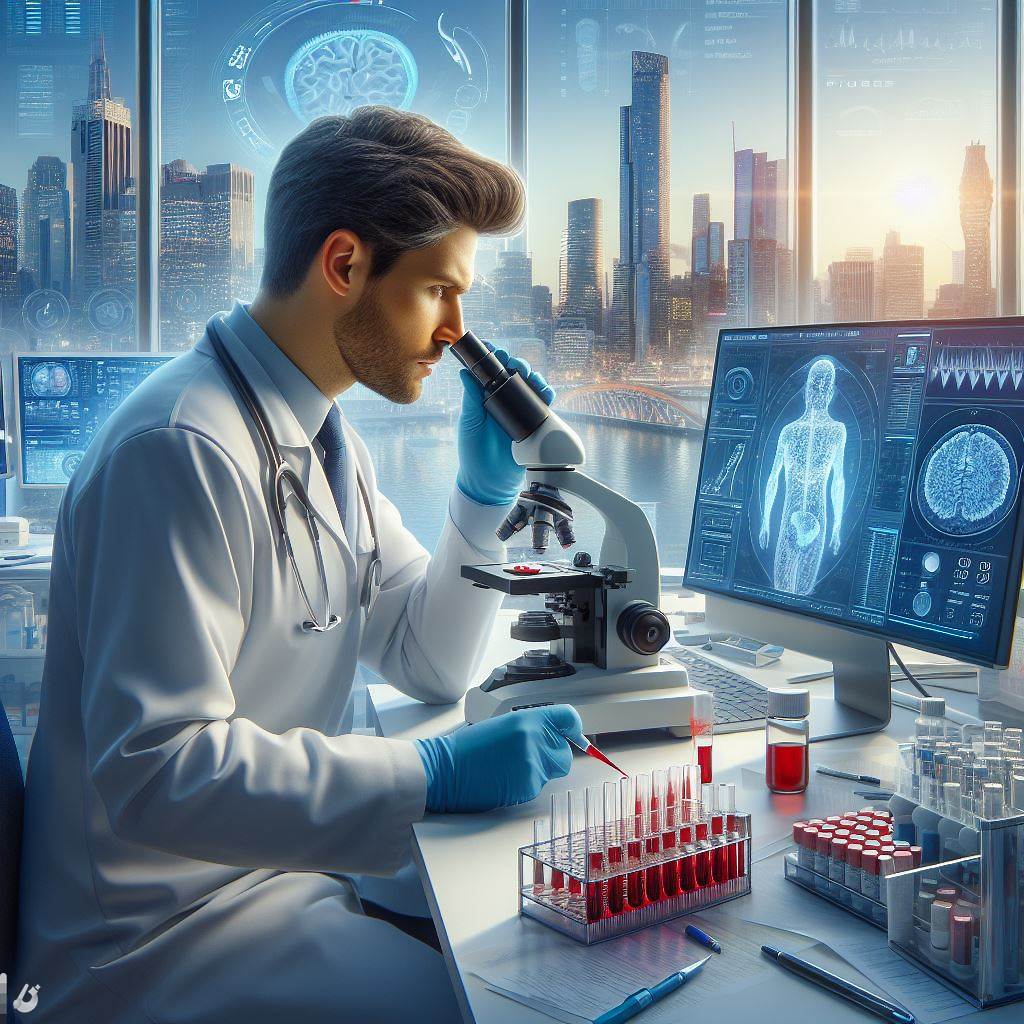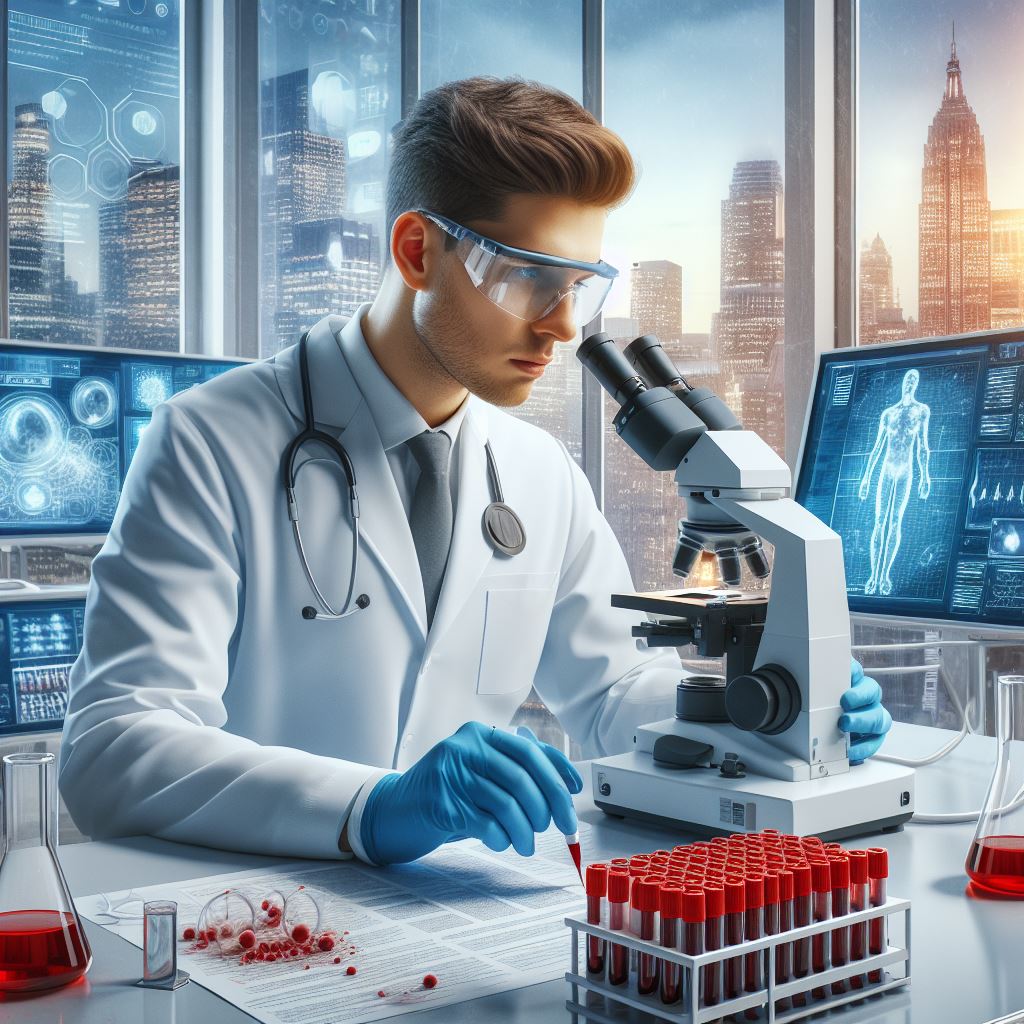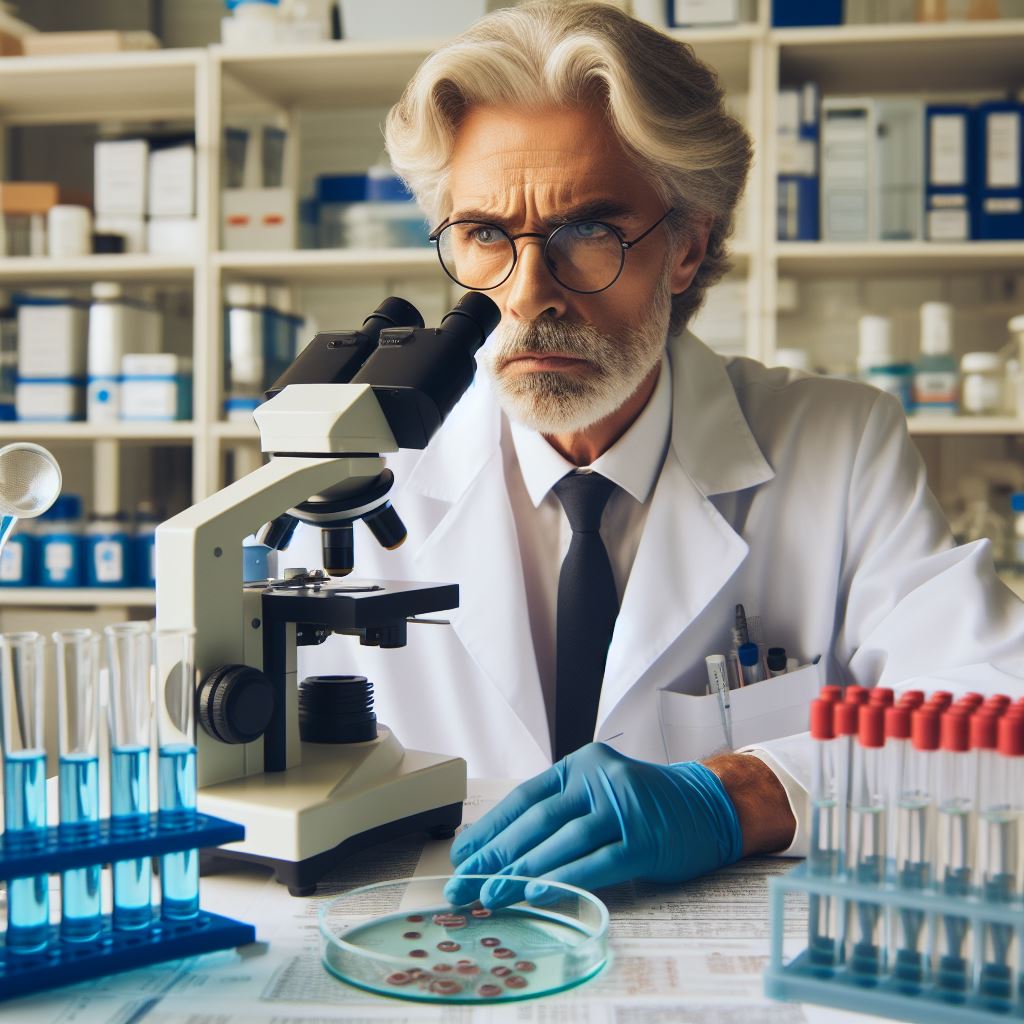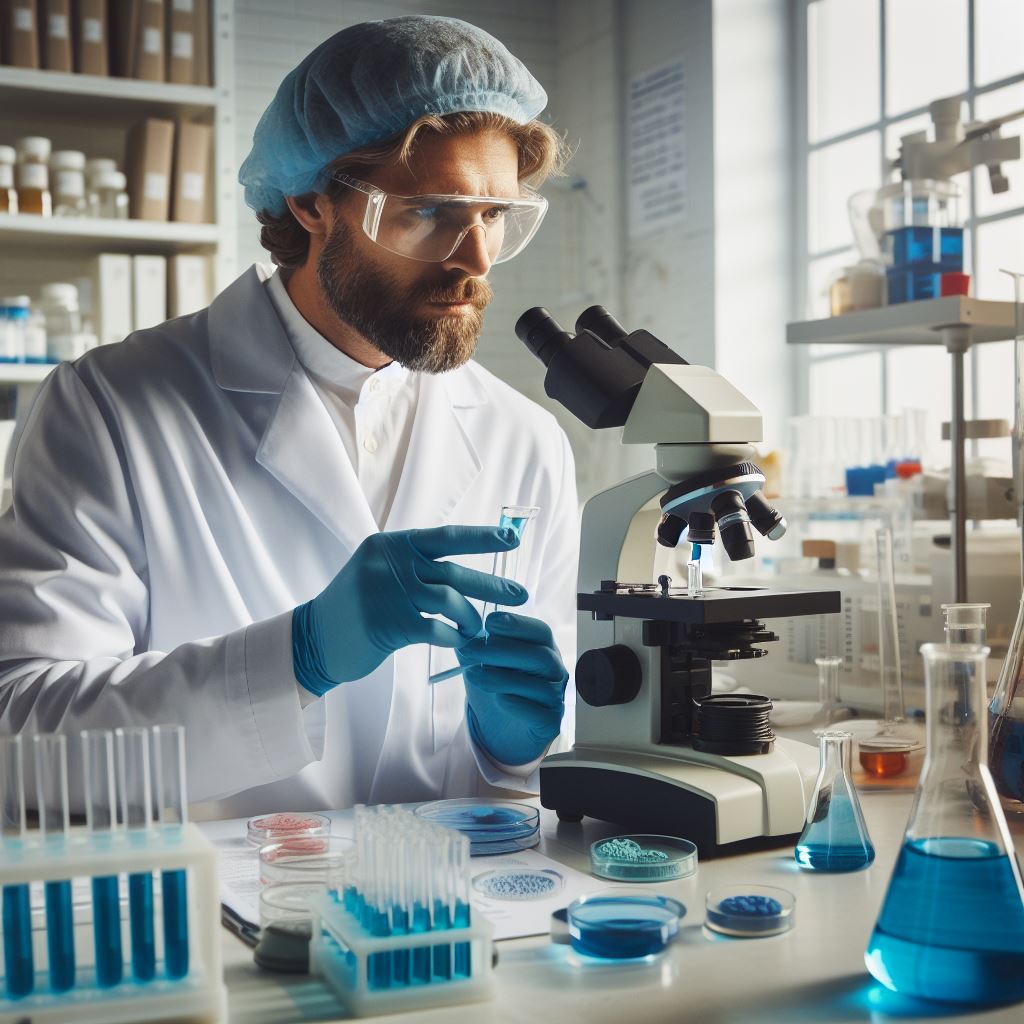Introduction
The medical technician field refers to professionals who use technology to diagnose and treat medical conditions.
Staying updated on the latest technology is crucial for medical technicians to provide the best patient care.
In the fast-paced world of medicine, technology is constantly evolving, and the field of medical technicians is no exception.
A medical technician is a professional who uses technology to diagnose and treat various medical conditions.
Staying updated on the latest advancements in technology is crucial for these individuals to provide the best possible patient care.
With the rapid advancements in technology, new medical devices and equipment are constantly being introduced into the healthcare industry.
Medical technicians need to stay updated on these innovations to ensure accurate and efficient diagnoses, as well as improve treatment outcomes.
Being knowledgeable about the latest tech also allows technicians to be at the forefront of medical advancements and deliver cutting-edge care to their patients.
Furthermore, staying updated on the latest technology helps medical technicians enhance their efficiency and productivity in the workplace.
They can utilize advanced computer systems and software to streamline their work processes, retrieve and analyze patient data more effectively, and collaborate with other healthcare professionals seamlessly.
This not only saves time but also improves the overall quality of care provided.
In review, keeping up with the latest technology is of utmost importance in the field of medical technicians.
It allows for accurate diagnoses, improved treatment outcomes, and increased efficiency in patient care.
By embracing the latest tech advancements, medical technicians can enhance their skills and stay ahead in the ever-evolving healthcare industry.
Overview of the Australian medical technician field
Australia has witnessed significant growth and development in the medical technician field, making it an essential part of the country’s healthcare system.
Medical technicians play a crucial role in providing quality healthcare services to Australian patients.
Growth and significance of the industry in Australia
- The medical technician industry in Australia has experienced rapid growth in recent years.
- This growth can be attributed to advancements in technology and an increased demand for healthcare services.
- Medical technicians’ role in diagnosing and treating diseases has become increasingly important.
- They are responsible for maintaining and operating medical equipment used in various healthcare facilities.
- With the aging population, there is a greater need for medical technicians to support healthcare professionals.
- The industry has expanded to include specialized fields, such as radiology and laboratory technology.
- Australia’s investment in research and development has further boosted the growth and significance of the medical technician field.
- Medical technicians contribute to the advancement of medicine by assisting in the development of new technologies.
- The industry’s growth has also created job opportunities and contributed to the country’s economy.
- Australia’s commitment to quality healthcare has made the medical technician field crucial in meeting healthcare standards.
Role of medical technicians in healthcare
- Medical technicians support healthcare professionals in accurately diagnosing and treating patients.
- They perform various diagnostic tests, such as blood tests, x-rays, and ultrasounds, to aid in diagnosis.
- Medical technicians ensure the accuracy and reliability of test results, helping physicians make informed decisions.
- They are responsible for operating and maintaining medical equipment used in hospitals, clinics, and laboratories.
- Medical technicians work collaboratively with healthcare teams, sharing their expertise and contributing to patient care.
- They provide crucial support during medical procedures, ensuring the smooth operation of equipment and patient safety.
- Medical technicians also play a significant role in research and development, testing new technologies and treatments.
- They stay up-to-date with the latest advancements in their field, continuously improving their knowledge and skills.
- Medical technicians adhere to strict quality control measures, ensuring the accuracy and reliability of test results.
- Their work is essential in the early detection and prevention of diseases, ultimately saving lives.
In essence, the Australian medical technician field has experienced significant growth and plays a crucial role in the country’s healthcare system.
The industry’s expansion, driven by technology advancements and increased demand, has created job opportunities and contributed to the economy.
Medical technicians’ support and expertise are invaluable in accurately diagnosing and treating patients, as well as contributing to research and development.
Their commitment to quality healthcare ensures the accuracy and reliability of test results, ultimately improving patient outcomes.
The Australian medical technician field is an integral part of the healthcare industry and will continue to evolve with advancements in technology and the changing needs of the population.
Read: Navigating Public Health Regulations in Oz
Benefits of adopting the latest technology in the medical technician field
Enhanced accuracy and efficiency in diagnostic procedures
- Improved imaging systems provide higher resolution and better visibility of diagnoses.
- Real-time monitoring devices allow technicians to track patient vitals accurately and continuously.
- Automation of laboratory tests reduces human errors and increases overall efficiency.
- Incorporation of artificial intelligence algorithms helps in accurate analysis and interpretation of medical data.
- Advanced software systems streamline the workflow and facilitate faster diagnosis and treatment decisions.
Improved patient care and outcomes
- The latest technology enables remote patient monitoring, reducing hospital visits and improving convenience for patients.
- Telemedicine platforms connect patients and doctors, increasing access to specialized care in remote areas.
- Electronic medical records allow seamless sharing of patient information among healthcare providers, leading to better coordination of care.
- Medical wearables and mobile apps enable patients to actively participate in their own healthcare management.
- Precision medicine, facilitated by cutting-edge technology, enables personalized treatment plans tailored to individual patients.
Streamlined administrative tasks
- Electronic scheduling systems optimize appointment scheduling, reducing waiting times and maximizing resource utilization.
- Automated billing and insurance claim processes eliminate paperwork, reducing administrative burden and errors.
- Inventory management software ensures the availability of essential medical supplies and reduces wastage.
- Machine learning algorithms help in predictive analytics, assisting in resource planning and efficient utilization.
- Automated reminders and notifications improve patient adherence to medical protocols and follow-up appointments.
By embracing the latest technology, medical technicians can significantly enhance their practices and improve patient care.
Through enhanced accuracy and efficiency in diagnostic procedures, better patient care and outcomes, and streamlined administrative tasks, the benefits are numerous.
The adoption of the latest technology empowers medical technicians to provide more precise diagnoses, monitor patients remotely, enhance coordination of care, and streamline various administrative processes.
Ultimately, the integration of technology in the medical technician field can revolutionize healthcare and improve the quality of patient care.
Read: Work-Life Balance in Public Health Jobs
Examples of the latest technology in the Aussie medical technician field
Advanced imaging technology
- High-resolution ultrasound machines
- 3D mammography systems
Advanced imaging technology has revolutionized the field of medical diagnostics in Australia.
The latest advancements in this area have allowed medical technicians to obtain clearer images, leading to more accurate diagnoses and improved patient outcomes.
High-resolution ultrasound machines
Ultrasounds have been a staple in medical imaging for years, but the latest high-resolution ultrasound machines take this technology to a whole new level.
These machines use advanced soundwaves to create detailed images of various organs and tissues within the body. Medical technicians can now identify abnormalities with greater precision.
3D mammography systems
Mammography has long been the go-to imaging technique for breast cancer detection. However, traditional 2D mammography has its limitations.
3D mammography systems, also known as digital breast tomosynthesis, offer a more comprehensive view of the breast tissue.
This technology has improved the accuracy of breast cancer screening and reduced the number of false-positive results.
Robotics and artificial intelligence applications
- Robotic surgical assistants
- AI-powered diagnostic tools
Robotics and artificial intelligence (AI) are transforming the way medical procedures are performed and diagnoses are made.
These technological advancements have streamlined processes and improved precision in the Aussie medical technician field.
Robotic surgical assistants
Robotic surgical assistants have the potential to revolutionize the field of surgery.
These machines are designed to assist surgeons during complex procedures, enhancing their precision and reducing the risk of human error.
With the help of robotic assistants, medical technicians can perform intricate surgeries with greater ease and efficiency.
AI-powered diagnostic tools
Artificial intelligence has made significant strides in the field of diagnostics. AI-powered diagnostic tools can analyze vast amounts of medical data and recognize patterns that may go unnoticed by human eyes.
This technology has the potential to speed up diagnoses, improve accuracy, and ultimately save lives by detecting diseases at an early stage.
In fact, the Aussie medical technician field is embracing the latest advancements in technology to improve patient care and outcomes.
Advanced imaging technology, such as high-resolution ultrasound machines and 3D mammography systems, offer clearer and more accurate images for diagnoses.
Robotics and artificial intelligence applications, including robotic surgical assistants and AI-powered diagnostic tools, enhance precision and efficiency in surgical procedures and diagnoses.
With these cutting-edge technologies, medical technicians in Australia are at the forefront of providing high-quality healthcare services.
Read: Australian Surgeons in Global Health Work
Your Personalized Career Strategy
Unlock your potential with tailored career consulting. Get clear, actionable steps designed for your success. Start now!
Get Started
Implications of the latest technology on medical technicians
Continuous professional development and training
With the latest technology advancements in the Australian medical technician field, it becomes imperative for professionals to engage in continuous professional development and training.
As new tools and techniques are introduced, it is crucial for medical technicians to stay up-to-date with the latest advancements in their field.
This not only ensures that they deliver high-quality care to their patients but also allows them to remain competitive in the job market.
Professional development programs and training workshops help medical technicians acquire new skills and expand their knowledge base.
By actively seeking opportunities for growth, these professionals can enhance their expertise and deliver the best possible outcomes to patients.
Through continuous training, medical technicians can also learn how to effectively use the latest technology in their day-to-day operations.
Embracing change and adapting to new processes
The latest technology introduces new processes and workflows in the medical technician field.
Medical technicians need to embrace these changes and adapt to new ways of working.
While it may require some initial learning and adjustment, embracing new processes can lead to improved efficiency and effectiveness in their work.
For example, the adoption of electronic health records (EHR) systems allows technicians to access patient information more quickly and accurately.
This streamlines the workflow and reduces the chances of errors, ultimately benefiting both the medical technician and the patient.
By embracing change and being open to new processes, medical technicians can improve their overall productivity and effectiveness.
Ethical considerations and maintaining patient privacy/security
The use of the latest technology in the medical technician field raises ethical considerations regarding patient privacy and security.
As medical technicians handle sensitive patient information, it is important for them to prioritize maintaining confidentiality and data security.
Technological advancements might introduce new risks such as data breaches or unauthorized access to patient records.
Medical technicians must remain vigilant in implementing appropriate safeguards to protect patient data from any potential breaches.
They should be well-informed about the legal and ethical obligations surrounding patient privacy, ensuring compliance with relevant regulations and standards.
Furthermore, they should stay updated on the latest cybersecurity threats and take necessary precautions to prevent any security breaches.
By actively addressing ethical considerations and maintaining patient privacy and security, medical technicians can build trust with their patients.
This, in turn, fosters stronger patient relationships and ensures that patients feel confident in sharing sensitive health information.
In general, the latest technology in the Australian medical technician field has significant implications for professionals in terms of continuous professional development and training, embracing change and adapting to new processes, and ethical considerations related to patient privacy and security.
By actively engaging in professional development, embracing change, and prioritizing patient privacy, medical technicians can leverage the benefits of the latest technology to deliver high-quality care and improve patient outcomes.
Read: Public Health Internships: A Guide in Oz
Stand Out with a Resume That Gets Results
Your career is worth more than a generic template. Let us craft a resume and cover letter that showcase your unique strengths and help you secure that dream job.
Get HiredDiscover More: Public Health Careers: Salaries in Australia
Impacts of the latest technology on patients and healthcare providers
Improved diagnostic accuracy leading to better treatment decisions
- Advanced medical technology allows for more precise and accurate diagnoses.
- This leads to more effective treatment plans, resulting in better patient outcomes.
- Doctors can make informed decisions based on reliable test results and data.
Quicker turnaround time for test results and diagnoses
- With the latest technology, medical technicians can perform tests and generate results more efficiently.
- This reduces waiting times for patients, providing them with faster diagnoses.
- Healthcare providers can also respond quickly and initiate appropriate treatment plans.
Potential cost savings for patients and healthcare facilities
- Advanced medical technology can lead to cost-effective solutions for patients.
- It minimizes the need for extensive hospital stays, reducing healthcare expenses.
- Healthcare facilities benefit from improved efficiency and reduced operating costs.
Overall, the latest advancements in medical technology have a significant impact on both patients and healthcare providers.
Medical technicians equipped with advanced technology can enhance diagnostic accuracy, leading to better treatment decisions.
Doctors can rely on reliable test results and data to make informed choices, resulting in improved patient outcomes.
Additionally, the latest technology allows for quicker turnaround times for test results and diagnoses.
This means patients can receive their results faster, allowing healthcare providers to initiate appropriate treatment plans promptly.
Reducing waiting times ultimately improves patient satisfaction and overall healthcare quality.
Moreover, advanced medical technology has the potential to save costs for both patients and healthcare facilities.
Instead of long and expensive hospital stays, patients can benefit from more efficient and cost-effective solutions.
Healthcare facilities can also reduce operating costs and improve overall efficiency, thanks to advanced technology.
However, it is essential to ensure that the latest technology is accessible to all healthcare providers and patients in Australia.
Equitable access to these advancements would further enhance the positive impacts and benefits they offer.
In a nutshell, the latest tech in the Aussie medical technician field has numerous impacts on patients and healthcare providers.
Improved diagnostic accuracy, quicker turnaround times for test results, and potential cost savings are notable advantages.
Transform Your LinkedIn for Maximum Impact
Elevate your professional brand with a LinkedIn profile that attracts recruiters, showcases your expertise, and maximizes opportunities. Stand out in your industry with a profile built for success.
Boost ProfileBy embracing and integrating these advancements, the healthcare industry can continue to enhance patient care and outcomes.
Investments in research and development should continue to drive innovation and address any potential challenges.
Overall, the latest technology has the potential to revolutionize the Australian healthcare system, benefiting all stakeholders involved.
Challenges and Limitations in Adopting the Latest Technology
High Initial Costs and Ongoing Maintenance Expenses
- The latest medical technologies often come with high upfront costs, making it a significant investment for healthcare institutions.
- These expenses may include purchasing equipment, installation, training, and software integration into existing systems.
- Ongoing maintenance costs such as regular updates and repairs can also be substantial and add to the financial burden.
Integration of Technology into Existing Healthcare Systems
- Integrating new technology into existing healthcare systems can be complex and time-consuming.
- Compatibility issues may arise when trying to merge different technologies and software systems.
- Seamless integration is essential to ensure a smooth workflow and avoid disruptions to patient care.
Resistance to Change and the Need for Proper Training
- Resistance to change from healthcare professionals can hinder the adoption of the latest medical technologies.
- Staff may be comfortable with existing procedures and hesitant to embrace new methods.
- Proper training becomes crucial to overcome this resistance and ensure effective utilization of the latest technology.
- Inadequate training can lead to errors, decreased efficiency, and compromised patient safety.
The adoption of the latest technology in the Australian medical technician field presents challenges and limitations that need to be addressed.
High initial costs and ongoing maintenance expenses can strain healthcare budgets. Integrating technology into existing healthcare systems requires careful planning and compatibility solutions.
Resistance to change can hinder progress, emphasizing the need for comprehensive training programs.
Overcoming these challenges is vital to harness the full potential of the latest technology and improve patient outcomes in the Australian healthcare system.
Conclusion
In concluding our exploration of the Australian medical technician field, we celebrate the profound advancements driven by cutting-edge technology.
The integration of state-of-the-art diagnostic tools and automated processes has expedited procedures, ensuring faster and more accurate diagnoses, ultimately elevating healthcare outcomes.
As we navigate these transformative changes, it is paramount to recognize that the field’s evolution is ongoing.
Staying updated and adaptable is not just a recommendation but a necessity in this ever-evolving landscape.
The rapid pace of innovation demands a commitment to continuous learning and proactive incorporation of emerging technologies.
The current state of advancements in the Australian medical technician field is impressive, but the future lies in the hands of those who embrace adaptability.
Lifelong learning and a proactive approach to technological integration will define the success of medical technicians.
They are not merely spectators in this dynamic landscape; they are the architects shaping the future trajectory of medical technology in Australia.
In essence, the journey doesn’t conclude with the current advancements; it extends to uncharted territories where adaptability becomes the linchpin.
As we bid farewell to this exploration, let it serve as a reminder that the pursuit of knowledge and adaptability is the key to continued excellence in the dynamic and ever-evolving field of medical technology in Australia.




